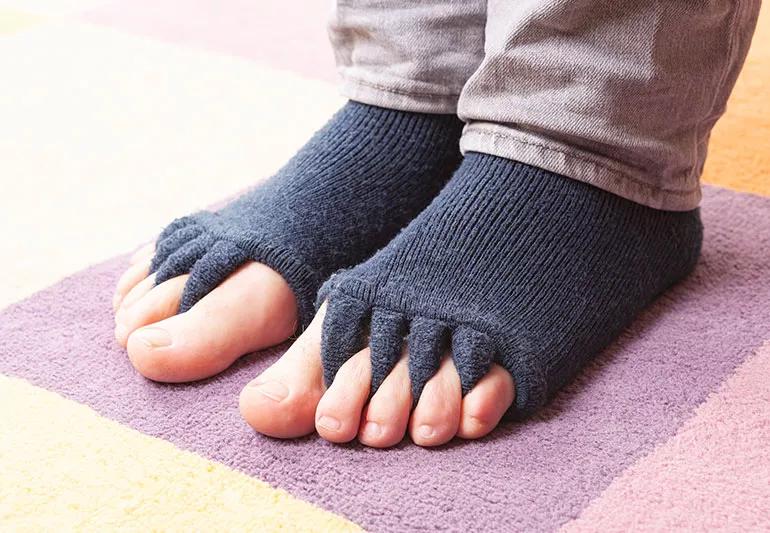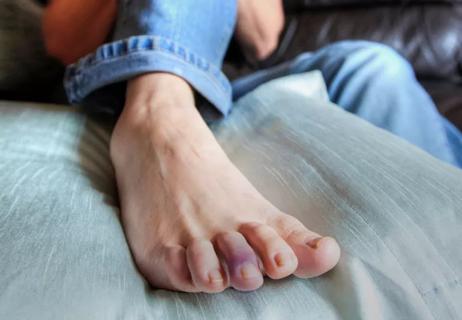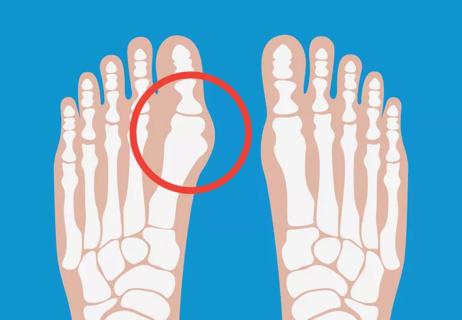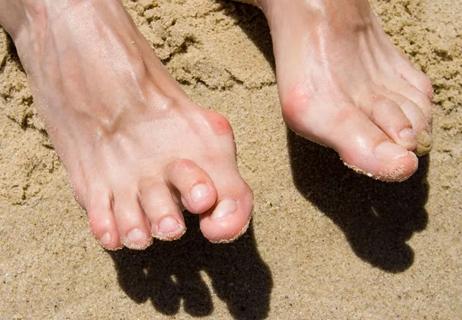Toe spacers and separators can add some comfort, but they’re not a fix-all

If your little piggies are less “wee-wee-wee” and more “ow-ow-ow” all the way home, you may be wondering how to give your toes a break. After all, those little phalanges have a big job to do.
Advertisement
Cleveland Clinic is a non-profit academic medical center. Advertising on our site helps support our mission. We do not endorse non-Cleveland Clinic products or services. Policy
Your toes help support your whole body and give you balance to stand, walk and run. So, when your toes are hurting from blisters, corns, calluses, bunions, crowding or toe deformities, your whole body can feel out of whack.
You’ve probably heard that wearing proper footwear is the first step (pun intended) to happy, healthy feet. But … well … life happens, and maybe you chose fashion over function in your footwear (it happens). Or maybe you’ve suffered an injury like a broken toe. Or you may be living with conditions like flat feet, rheumatoid arthritis or other issues that affect your feet.
There are entire displays at your local drug store dedicated to devices that promise to protect your toes. Search it out on an online retailer and you’ll find pages and pages of results and reviews for devices that claim to cure your aching toes.
But what’s the deal with all those different kinds of toe-spacing and toe-separating apparatuses? Are they the cure-all for your tootsie troubles?
We talked with podiatrist Georgeanne Botek, DPM, about toe spacers and separators and what they can — and can’t — do for you.
There is a wide range of toe spacing and separating fixes out there. Some are similar to those separators you use between your toes during a pedicure — essentially, a row of foam with cut-outs for your tootsies. Others look more like individual pillows that you place between your toes. And then there are the others that wrap around each individual toe.
Advertisement
And they come in different materials, too — they can be made from felt, foam, silicone and other substances.
It’s enough choices to knock you off your feet.
Dr. Botek says choosing a toe spacer or toe separator comes down to comfort and the problem you’re looking to fix.
“In general, I like the pads that are made of silicone because they’re spongy but keep their shape well. Most of the time, those are reusable, too, so you’re not throwing them out every time you use them,” Dr. Botek says. “I also usually recommend an open-toe pad. Anything that closes over your toes won’t let your toes breathe as much.”
If your toes are close together, the spacers that you place between each toe can work well. But for people with more flexibility and movement in their toes, they’re liable to slip out of position and wind up bunched up in your socks. No one wants that.
A trip to a specialty shoe store or a talk with a healthcare provider can help you navigate your options and find the best solution for you.
The thing to remember is that most toe spacers aren’t going to reverse any damage that’s been done, Dr. Botek notes. The exception: A specialized device that’s worn outside of shoes, while resting your feet. A common example is the brand Yoga Toes®.
“Toe spacers that are meant to be worn in your shoes are like eyeglasses,” Dr. Botek says. “These devices will work while they’re on, but they’re not correcting a problem at its root. When you take your glasses off, your vision hasn’t changed. It’s the same with toe separators and spacers. They won’t have a lasting effect on your feet.”
While they won’t permanently alter your toes or heal bunions, spacers and separators can help give your piggies some temporary relief and prevent some of the most common concerns. Dr. Botek shares these three reasons to give spacers and separators a try.
If you find that your toes are crowding together, overlapping or bending upward (also known as hammertoe), or if you have bunions, you might consider toe spacers to give them some breathing space. Toes that have been scrunched up in socks and shoes can benefit from a good stretch.
Again: Spacers and separators you wear in your shoes aren’t going to provide lasting results (despite what their packaging may claim). For lasting relief from these issues, talk with a healthcare provider about your options.
Toe spacers and separators can be a good choice for preventing some of the most common (and annoying) concerns. Spacers can be used to keep your toes from rubbing on your shoes. Repeated friction between your toes and your shoes can cause:
Advertisement
Keep in mind, though, that adding spacers or separators can change the way your shoes fit, particularly if your shoes are narrow at the toes. So, if you plan on wearing separators with your footwear, be sure to try on your shoes with the device on and take a good walk in those shoes to make sure you’re actually fixing the issue and not making it worse.
Yes, your best bet is to wear well-fitted, low-heeled, well-padded shoes. All the time. But when you have one of those occasions when your footwear isn’t quite up to that standard, toe spacers can give you some added comfort.
Dr. Botek says toe spacers and separators can be used without much risk for many people, but that doesn’t mean they’re right for everyone. Talk with your doctor about your options if you:
If you find yourself needing to cushion your tootsies on the regular, you’d probably benefit from talking with a healthcare provider about other options, Dr. Botek advises.
“If you find that you’re having pain despite wearing accommodative padding or toe spacers, you’d probably want to get checked out. Or if it’s a problem that isn’t going away, there may be other things that can and should be done,” Dr. Botek adds.
Advertisement
Learn more about our editorial process.
Advertisement

Some things you find in your house have antifungal properties — but that doesn’t mean they’ll clear your toenail fungus

Wearing shoe inserts, maintaining a healthy weight and using cold or heat therapy may give you relief

Injuring a toe is painful, but is it a serious problem? Find out when to see a doctor and what to do to help your toe heal at home.

The short answer from an orthopaedic surgeon

Understanding hammertoe, mallet toe and claw toe

Your knees could be hurting at bedtime because of inflammation, injury or some other condition that gets worse with pressure and positioning

Hanging upside down for any length of time may decompress the tension in your spine

Stretches, exercises and posture changes can help address lower cross syndrome

Babies can get congested easily, but you can calm their cough by keeping them hydrated, using nasal drops and running a humidifier

Weight loss may cause loose, sagging skin and muscle loss to your rear

Several conditions, like vitiligo and fungal infection, can cause a loss of pigmentation, leading to white spots or patches on your skin